РИММА И ВАЛЕРИЙ ГЕРЛОВИНЫ
ВЫДЕРЖКИ ИЗ КНИГ И КРИТИЧЕСКИХ СТАТЕЙ О РАБОТАХ
Part 4: publications 1996 - 1977
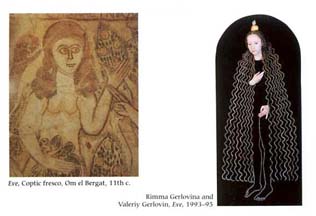
Bill Moyers, Genesis. A Living Conversation. Book companion to the public television series, and video, Doubleday, 1996.

"They also lifted from thousand of years of human history the seminal images and patterns mankind has employed to make sense of the mysteries of the universe. Few contemporary artists have addressed this paradox as cleverly as the Gerlovins."
Joanne Milani "New York - the Arts" (exhibition at Sainbaum-Krauss Gallery, New York), The Tampa Tribune-Times, Sunday, June 4, 1995.
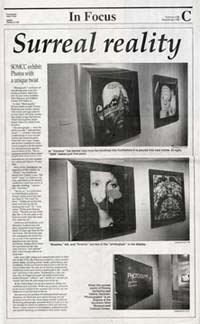
"Photoglyphs" combines art and photography in an eye catching display which can now be seen at the Southern Ohio Museum... Embracing photography permitted the artists to work in a context familiar to American audience while still allowing them to retain elements of performance, political tension, and layered meanings so essential to their earlier works."
J. S, Moses, "Surreal Reality" ("Photoglyphs" at Southern Ohio Museum), Daily Times, Portsmouth, OH, Feb. 19, 1995.
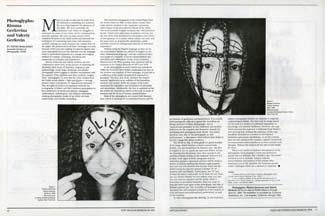
"...with mathematical, mythological, and religious symbolism, creating photographic works of art which are both intellectually and visually compelling... In the Photoglyphs (a series which was initiated in 1989) the Gerlovins have further emphasized the face as the location and medium of their messages. In part, this is a reflection of the artists' metaphysical approach to geometry. The face, as a circle, assumes that shape's semiotic significance as an emblem of the boundless, spiritual, and eternal, while the square of the frame represent the imposition and boundaries of rationality and materialism.
Most of the photographs are created with Rimma's face, which is stunning for its anatomical beauty and for its assertion of gentleness and benevolence. It is actually anthropologically difficult to ignore the surveillant yet benign presence of these photographs. And in "oppositional symmetry" to this subliminal ad intuitive seduction are the cognitive and discursive rewards for examining each photograph more closely."
Steven Maklansky, "Photoglyphs: Rimma Gerlovina and Valeriy Gerlovin" Arts Quarterly. New Orleans Museum of Art, vol. XVI, is. 1, 1994, pp.10-11.
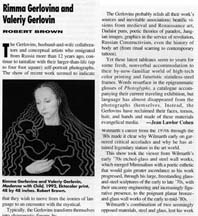
"The Gerlovins transform themselves into shamanic figures by painting their faces and upper bodies with palindromes and visual riddles. In Madonna with Child, however, a luminous and unmarked Rimma becomes a figure who emanates power... They probably relish all their work's sources and inevitable associations: beatific visions from medieval and Renaissance art, Dadaist puns, poetic theory of paradox, Jungian images, graphics in the service of revolution, Russian constructivism, even the history of body art (from ritual scarring to contemporary tattoos).
Yet these latest tableaux seem to yearn for some fresh, non-verbal accommodation to their by-now-familiar world of high-tech color printing and stainless-steel futuristic frames. Words resurface in the epigrammatic glosses of Photoglyphs, a catalogue accompanying their current traveling exhibition, but language has almost disappeared from the photographs themselves. Instead, the Gerlovins have reclaimed their faces, torsos, hair, and hands and made of these materials evangelical media."
Jean Lawlor Cohen, "Rimma Gerlovina and Valeriy Gerlovin at Robert Brown Gallery", ARTnews, Apr. 1994.
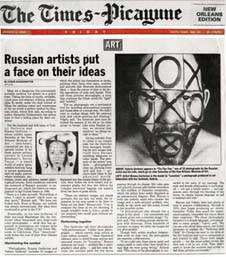
"For the husband and wife team of Valeriy Gerlovin and Rimma Gerlovina – whose exhibit opens Saturday at the New Orleans Museum of Art – idea-based, conceptual art was a natural cause... "There is a Latin proverb: 'Everything of mine, I carry in myself,' which sums up that move (from Russia to the U.S.)," Rimma said. "We have not looked back. Even in Russia, our outlook was always international. Our ideas have continued to grow in the U.S."
Exhibition of "Photoglyphs" includes 33 images in which the artists use themselves as props, painting their faces with signs, symbols and pictures that illustrate philosophical ideas – from the nature of time to the fertile oppositions of male and female... We didn't want to confuse things with the personal style that colors painting and drawing," Valeriy said. "An American poet once described the essence of his art as 'not in ideas, but in things.' Like most Russian artists, we reverse that equation: 'not in things, but in ideas'... But the presence of the artists' own faces – photographed close up, showing every lash and line – anchors their ideas in the physical world...
In "Lunation," Rimma embraces her head – griddled like a cartographer's ideal globe – and her arms become the circular path for the moon passing through its phases. Her calm gaze and graceful posture add further resonance to this emblem of feminine complexity, which the artists have neatly disguised as an astronomical diagram. Here Rimma is both the orderly mind who creates the image and a pale-skinned goddess who dwells in the earth and the moon, bound to her monthly cycles...
"We chose photography because it's a simple language, understandable to many people," Valeriy said. "We can say a lot about these pieces, but it isn't necessary to explain the "Madonna with Child." In Chicago we went to our show at the Art Institute and visitors recognized us and started to talk. These were simple people – not the usual gallery crowd... They didn't need to know the symbols and myths to feel these pictures emotionally."
Chris Waddington "Russian Artists Put a Face on Their Ideas", The Times-Picayune, New Orleans, March 4, 1994.
"Р. Герловина строит свои работы как интимную игру ума и души с анонимными архетипами, обнаруживающию имманентность мифологических ходов самой природы человеческого мышления...
В большинстве фотоперформансев Риммы и Валерия Герловиных ("Зеркальная игра", 1977; "Деревья". Сны Риммы и Валерия Герловиных", 1978)... фотографии служили лишь точками опоры для умозрительной игры, участвовать в которой предлагалось зрителю... Именно она представляет собой основной предмет и основную проблему их перформансов, а также близких им по духу "утопических проектов"...
Игровой компонент очень важен для концептуального искусства. Игра в концептуализме предстает как форма деятельности, позволяющеая максимально нейтрализовать гегемонию языка."
Екатерина Бобринская книга "Концептуализм", Галарт, Москва, 1994.

"The Gerlovins' most recent collaborative works explore the fertile intersection of linguistics, mythology, painting, performance, sculpture, and photogrpahy...By presenting visual and textual conundrums, they invite the viewer to participate in unraveling the paradox, thus forming a bridge to spiritual and mystical transformation."
Mark Sloan, "Exploring the capricious Nature of Language" The Chronicle of Higher Education, Jan. 12, 1994.

"Many of the images refer to an iconography of universal knowledge - with allusion to Christian symbology, alchemy, numerology, contemporary American culture, and other art...This clever collaboration of photography, painting, words and theater is viscerally provocative. With her huge eyes, almond-shaped face, long nose and deadly pale skin, Rimma Gerlovina stares out at the viewer with the sad-eyed longing of a gothic madonna...In "Photoglyphs," Rimma and Valeriy Gerlovin use their flesh to tell the human story with intensity, elegance and humor.
Cyrus B.Last, "Photoglyphs" (exhibition at Selby Gallery, Ringling School of Art and Design, Sarasota, FL), Sarasota Arts, Dec. 1993, cover.
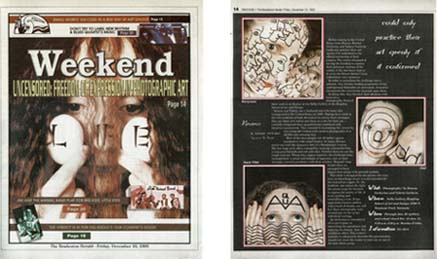
"They succeed in fascinating the viewer by conveying old wisdom with modern photography in a skilful and amusing way. Most of the photographs are 48 inches square, mounted in the wide metal frames. In many, Rimma stares out with the impassive face of a Renaissance woman. She has huge eyes, often enlarged by makeup, a beautiful face, a long graceful neck, and soft skin. Valeriy's features are the rough contrast. Where they appear together, the Gerlovins have accomplished a union and balance of opposites, just as their messages unravel paradoxes with their artistry...
In the forefront, one senses the fight the artists wage for freedom to express the poetry of life. It is an exciting and entertaining event. If one appreciates humor, pathos and a touch of drama, one will feel these photographs were created just for his or her individual viewing. An invitation is extended to all to participate in unraveling the paradoxes and enjoying the beauty that this exhibition offers. This writer's inability to adequately describe this presentation should not cause the reader to miss out on one of the best shows going.
Woody Shulman, "Review" (Photoglyphs at Selby Gallery, Ringling School of Art and Design, Sarasota, FL) The Bradenton Herald, weekend magazine, Friday Dec. 10, 1993, cover.
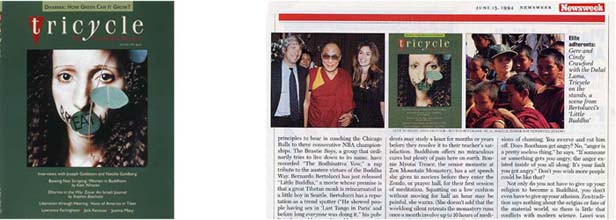
Tricycle (Buddhist Review), winter 1993, cover, and its reproduction in the article on Buddhism "800,000 Hand Clapping", Newsweek, June 13, 1994.
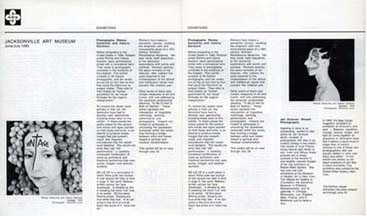
"Rimma"s face makes a wonderful canvas, recalling the enigmatic calm and monumental stasis of 16th-century Northern Renaissance Madonna. Her face lends itself beautifully to the Gerlovins' explorations with words and symbols. Rimma's serenity, the spare formality of her features, offer viewers the quiet essential of the ethical and intellectual values that concern this creative pair."
Jacksonville Art Museum Booklet for the exhibition Photoglyphs, Jacksonville, Fl, June/July 1993.
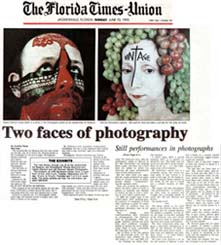
"The art form of Rimma Gerlovina and Valeriy Gerlovin is body calligraphy... Ms. Gerlovina, even unpainted is particularly transfixing. She has a long, balanced 16th-century face with a high forehead, right off a Botticelli painting... Photoglyphs is 30 photos of the two, their bodies painted with glyphs, which are more than words; they are characters or symbols that give a signal. Sometimes those signals make you laugh, and then they puzzle you, which is just what the man and wife intended. "Body and skin become human parchment for our visual formulas for the organic metaphysics," they wrote."
Woody Cynthia Parks "Two Faces of Photography", review on Photoglyps at Jacksonville Art Museum, The Florida Times-Union, Sunday, June 13, 1993, Jacksonville, FL.
"Rimma Gerlovina and Valeriy Gerlovin's collaborative series of photographs at Robert Brown Gallery wouldn't be nearly as effective if Gerlovina didn't have the face of a Northern Renaissance Madonna. Her large impassive eyes, tiny mouth and porcelain skin lend these portrait-style color shots an aura of art historical authority, the perfect foil to the disconcerting words painted on her face and occasional props imposed on her.
Once in vanguard of Russian underground art, the couple now employs their sophisticated wit to tease the viewer into pondering visual and linguistic puzzles that invariably lead to deeper questions on subject as wide-ranging as religion, science and the nature of being. Sleekly silhouetted on black, each image reads like a cryptic diagram promising universal truth. The months of the year march across Gerlovina's arms as they cradle her head; the word "chaos" on her forehead connects as in a molecular diagram to letters floating randomly on her cheeks and nose.
The outward comic absurdity of these works is underpinning with paradoxes... Her braided hair flows in ways suggestive of the waters of life or umbilical cords. The braids are arranged like lines in a drawing to resemble the Child in her arms, a connection as indicative of self-absorption as of motherly love. Based on a powerful icon of motherhood and goodness, this image also illustrates the psychological cost of selflessness." Mary McCoy, "Peeling off the Layers of Being", The Washington Post, Saturday, Oct. 30, 1993.
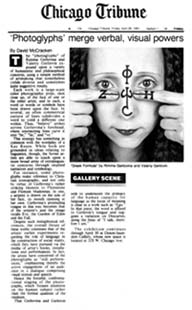
"The Photoglyphs of Rimma Gerlovina and Valeriy Gerlovin expound upon a variety of humanistic and philosophical concerns, using a simple method of art making that nonetheless yields divers and sometimes quite suggestive results... For instance, some photoglyphs make reference to Christian iconography, and not only by virtue of Gerlovina's rather striking likeness to Florentine and Flemish Madonnas. In one, a serpent is drawn on the side of her face, its mouth opening at her own. Gerlovina's protruding tongue in this way becomes that of the serpent's and the image recall Eve, the garden of Eden and the Fall. Despite such metaphysical reference, the overall thrust of these work continues that of the artists' earlier experiments regarding the role of language in the construction of social reality, which they pursued via the media of artist's books, installations and performances... That Gerlovina and Gerlovin seek to underscore the primacy of the human capacity for language as the locus of meaning is clear in a work such as "Ego." In that piece, the word is affixed to Gerlovin's tongue and suggests a variation of Descartes, along the lines of "I talk, therefore I am."
David McCracken, "Photoglyphs" Merge Verbal, Visual Powers", Chicago Tribune, Friday, April 26, 1991.
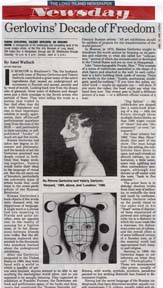
"In Moscow in Brezhnev's '70s, the husband-and-wife team of Rimma Gerlovina and Valeriy Gerlovin contributed a great many of the active ingredients that caused an underground art movement to flourish and spread... They organized an exhibition at Franklin Furnace, the Downtown art-book and performance space, of the books and documentations that constituted that constituted the "Russian samizdat art" of the artistic underground. And they evolved a definition of samizdat that permitted them to keep alive its spirit, even in Soho: "Samizdat art is not an institution, but a strategy."
The Fine Arts Museum of Long Island has done us the great favor of gathering together a retrospective of 104 of the Gerlovins' works from the past decade. It's a particular strong exhibition of work by artists who are long overdo for this type of scrutiny. And it's an object lesson in how an artist can make the mind-boggling transition from a totalitarian to a free-for-all culture with dignity, integrity and some damn good art.
For sheer artistry her 1983 "One Man Show" sculpture steals the part of the show. The man hangs from the ceiling, the cubby holes have doors to open, and each reveals an absurd tableau, an exhortation, a little scene, some with uplifting and often contradictory messages, although on throws us off center with the note: "back in five minutes."
Valeriy Gerlovin relies on the purely visual to the same end in his "Head" series of disjointed faces constructed of plywood and syringes or nails in which the nose reads like a staircase, the dislocations come out of cubism, and the overall effect is of some billboard version of a Russian icon...
Starting in the mid of '80s, the Gerlovins began to collaborate on what they call "Photoglyphs." These are monumental C-prints, usually of Rimma, with words, symbols, numbers, paradoxes painted on her strikingly Botticelli face framed in Renaissance ringlets...
There's endless invention here, disciplined and consistent. The exhibition is an object lesson in how to survive the dislocations of history to make art that counts." Amei Wallach, "Gerlovin's "Decade of Freedom", Newsday, May 31, 1991.
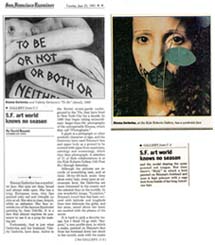
"Rimma has a symbolic face. Her eyes are deep, broad, and always wide open... Her skin is clear, limpid, white as alabasterÉIt is a face that almost require its possessor to use it as a prop for making art.
Active in the Soviet avant-garde underground in the '70s, they lived in New York City for a decade. In the mid '80s they began taking extraordinary larger-than-life photographs of the unforgettable Rimma, which they call "Photoglyphs"... Although the pictures are records of something real, and at their 38-by 38-inch scale they show every hair, every pore at microscopic level, the Gerlovins are more interested in the cosmic and the celestial than in worldly. In one wonderful image, "Lunation," Rimma's round face has been covered with latitude and longitude lines that delineate the globe, and her arms, raised above her head, are marked with the phases of the moon."
David Bonetti, "S.F. Art World Knows No Season", San Francisco Examiner, June 25, 1991.
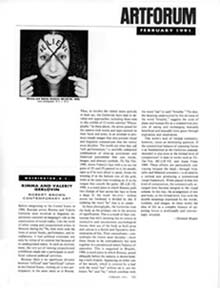
"The results are what they call "still performances," a carefully composed combination of close-up portraiture and theatrical pantomime that uses words, images, and abstract symbols. Tic-Tac-Toe, 1990, shows Valeriy's face with tic-tac-toe game of X's and O's painted on it: his mouth, open as if he were about to speak, forms the winning O in the bottom row of the grid, while at the same time revealing an X on his tongue that cancels the game... The arrangement of text and body, at the formal level, fuse with the double meaning expressed by the words, symbol, and images. In these works the idea of life as a complex balance of opposing forces is profoundly and convincingly revealed.
Howard Risatti "Rimma and Valeriy Gerlovin at Robert Brown Contemporary Art", Artforum, Feb., 1991.

"The artists use their faces as instrument, the way a soprano uses her voice. Segmented, painted, or "collaged," they become a visual intense and provocative "medium" through which to express complicated ideas about the nature of the world. Like early Egyptian hieroglyphs, whose forms represent abstractly the concept they signify, the face becomes the symbol for art and layered meaning it communicates.
Each Photoglyph seems to condense the history of European art, as if to insist on the continuity of the tradition... That can be read as the exact antithesis of the "state of the world" message implicit in Jeff Koons's porcelain couplings, Photoglyphs spotlights the sensate difference between modernist and postmodernist art, highlighting the reality of one as the flip side of the other."
Florence Rubenfeld, "Rimma Gerlovina/Valeriy Gerlovin", Arts magazine, Jan. 1991.
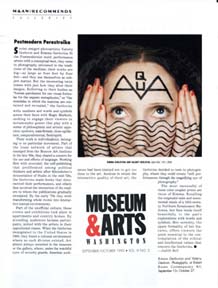
"Their works are big – as large as four feet by four feet – and they use themselves as subject matter. But the interesting twist comes with just how they alter their images. Referring to their bodies as "human parchment for our visual formulas for the organic metaphysics," or "the mandalas in which the mantras are contained and revealed," the Gerlovins write numbers, words, and symbols across their faces.
The most successful of these color coupler prints are those of Rimma. Recalling the enigmatic calm and monumental stasis of a 16-th-century Northern Renaissance Madonna, her face lends itself beautifully to the pair's explorations with words and symbols. Her serenity, the spare formality of her features, offers viewers the quiet essential to the contemplation of the ethical and intellectual values that concern the Gerlovins." Judith Bell, "Postmodern Perestroika", Museum and Arts magazine, Sept. 1990.

"The work consists of eight Cibachrome prints that, being a yard square, get a gallery to themselves. They are the work of Rimma Gerlovina and Valeriy Gerlovin, a husband and wife team from the Soviet Union. Each image is a portrait of Mrs. Gerlovin. Her oval face with its large eyes, vestigial eyebrows and a nimbus of long braided hair could be the creation of some early Flemish master, but not the black signs and symbols painted on it.
Apparently, these "Photems," as they are called, have their roots and ideas developed during the short-lived Russian Futurist movement and in Walter Benjamin's essay, "The Work of Art in the Age of Mechanical Revolution." But for the artists, who were active in Moscow's underground art movement and have recently produced a book called "Russian Samizdat Art," they have mystical as well as political significance."
Vivien Rayner "Religious Symbols at the Altar of Artistic Invention", review on the exhibition at the Bronx Museum, NY, The New York Times, Sunday, June 11, 1989.
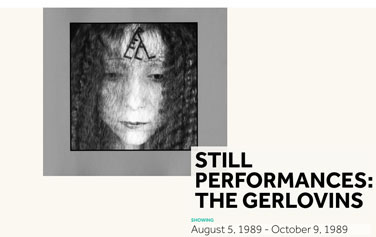
"Rimma Gerlovina and Valeriy Gerlovin mix performance with numerological signs and mystical texts painted across their serene and sometimes intense faces. Unlike certain contemporary work integrated with text, their work is visible alert and often entrancing...The integration of opposites in these staged color photographs, they believe, can lead to mystical transformation. Their work is quizzically static yet intrinsically volatile. Nothing in the photographs is to be considered as fixed in time, certified as visual truth. The artists offer these images as metaphoric bridges to sacred knowledge. They hope that the viewer will complete an unfinished text, one that is to function like a mantra... The concepts are whole and salient and interdependent; they somersault joyously in mind."
Kelly Wise, "Static Yet Volatile Images", The Boston Globe, Sept. 28, 1989. (Link to the info about the exhibition Still Performances at MIT)

"The photograph indicate careful planning, and it wants to say a lot. "A HEAD" becomes "AHEAD," (Of what you ask. To where? Why? How?) Then it becomes "A-HE-A.D." (about a man A.D, i.e. now" the subtitle reads)...
"Body decoration," notes Sylvia Wolf,a curatorial assistant in the Art Institute's Department of Photography, "has been used across continents from as early as 15,000 B.C. in life-cycle rituals and spiritual ceremonies, to display wealth or to enhance beauty." The artists use the decorated body in all those ways and more. "They have looked to the past," says Wolf," and brought the symbolism from the past to us and made it contemporary. The work has that wonderful edge of seriousness; it's compelling, provocative, and it's funny."
It's also, sometimes, exquisitely beautiful, as in "Neck of Alphabets," where Gerlovins's neck portrayed against a blue-green background, is ringed with precisely drawn letters from nine of the world's languages: Russian, English, Greek, Sanskrit, Arabic, Chinese, Hebrew, Cuneiform and Egyptian...
To Rimma Gerlovina, the bodies decorated with pictures, painted word puzzles and puns are images she hopes will lead viewers to "open the soul, to look inside." Ethical standards for life are extremely important," she says. "We have to rely not only on social sources of information, but we have to look inside for development. The more we develop inside, the better we deal with each other and improve the world."
In "Magic Square,"the numbers painted on the grid across Gerlovins's face always add up to 15...After the initial surprise - and fun - of seeing a face painted into a grid for numbers, the viewer is left to puzzle over the precision of the numbers, the mathematical laws of the universe, the body as the focus of the art and also its basis, its relationship to the universe, and on and on...
Gerlovina agrees with Wolf; the humor and wit in the works are "extremely important." She compares the elements of paradox and the nonsensical and grotesque in the photems with the koans used in Zen Buddhist training. "The koans," she says,"have the elements of a joke a little bit twisted. People understand more from a joke."
Catharine Reeve, "Art Institute Exhibits Offer Latter-day and Early Pioneers", Chicago Tribune, May 12, 1989.
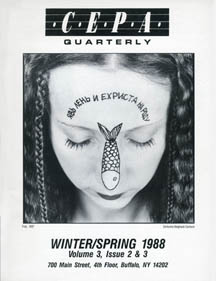
Photems by Nicolai von Kreiter, CEPA magazine, Buffalo, NY, 1988 (link to pdf)
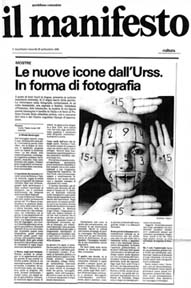
Mirella Bentivoglio, "Le nuove icone dall'Urss in forma di fotografia", Il Manifesto, Italy, Sept. 23, 1988.
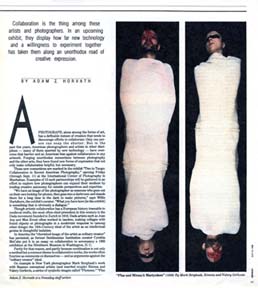
"Though artistic collaboration has a European history traceable to medieval craft, the most often cited precedent in this century is the Dada movement founded in Zurich in 1916. Dada artists such as Jean Arp and Max Ernst often worked in tandem, making collages with found objects or photographs in a modernist response to (among other thing) the 19th-Century ideal of the artist as an intellectual genius in thoughtful isolation. Partly for that reason, and partly because combination is not only a method but a common theme in collaboration works, the works often function as comments on themselves - and as arguments against the "solitary creator" ideal... "Plus and Minus," an eerie view of the Gerlovins cocooned together connects with the viewer as a psychological portrait of the Gerlovins and a symbol of the interdependence of human beings. That interdependence, the artists say, also reflects the very concept of collaboration."
Adam Z. Horvath "Two to Tango. (Exhibition at the International Center of Photography)", The Newsday Magazine, July 10, 1988.
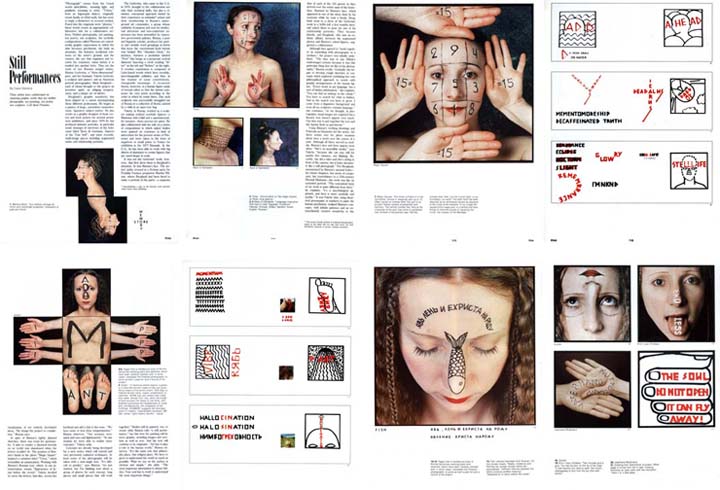
"Neither photography, nor painting, nor poetry, nor sculpture, the symbolic configuration called Photems are mixed-media graphic expression in which the skin becomes parchment, the body an armature, the features accidental contours on the artist's ground, and the camera, the eye that organizes and records the transitory vision before it is molded into another form... The Gerlovins brought to the collaboration not only technical skills, but also a visionary experience as samizdat artists... with zest for intellectual adventure and non-conformist expression.
In spite of Rimma's tightly planned sketches, there was room for spontaneity..."Art has to play a role in the human world," she observes. "It's the same role that philosophy plays, that religion plays. We have to grow to understand the world as much as possible. What we see on the surface is obvious and simple. The most important information is always hidden. You soul has to work to understand the most important things." Carol Stevens, "Still Performances", Print magazine, March/April, 1988.
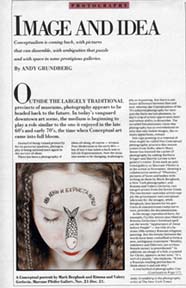
"In today's vanguard downtown art scene, the medium is beginning to play a role similar to the one it enjoyed in the late 60's and early 70's, the time when conceptual art came into full bloom... Rimma and Valeriy Gerlovin, two émigré artists from the Soviet Union, the former samizdat artists supply the greasepaint and conceptual lubricant for the images... In the image reproduced here, for example, Cyrillic letters inscribed on Rimma Gerlovina's forehead spell out the words "Appearance of Jesus before People" - the title of a famous 19th century Russian religious painting. But the breaks between the words have been reshuffled to form a new, ambiguous statement..."
Andy Grunberg, "Image and Idea", preview of the new season exhibitions, The New York Times Magazine, August 30, 1987.

"The longest essay, "Samizdat Art", by Rimma and Valeriy Gerlovin, is devoted to contemporary issues. Both artists were deeply involved in the art movements of the 1970s, mainly in Moscow, but also in Leningrad and the Baltic state. Consequently, they have every qualification to define and evaluate the development of the new avant-garde in the Soviet Union and then abroad. They do this from their own particular standpoint as artists, as theoreticians, and as witnesses of the very events that they describe. From my point of view, which is that the contemporary criticism of art should be written only be the artists themselves, the Gerlovins' text is especially valuable. Perspicacious, often provocative, this long essay provides much new information (albeit sometimes of a subjective nature) that helps us to understand better –documentarily – the evolution of modern Soviet art, and it is a welcome change from the often unrealizable descriptions that Western critics have provided."
Nicoletta Misler, review on book "Russian Samizdat Art", Willis Locker and Owens, New York, NY, 1986", Leonardo, vol. 21, No.1, 1988, pp. 102-103.
"The exhibition "Russian Samizdat Art", showing over a hundred works by about thirty artists, was curated and designed by artists Rimma and Valeriy Gerlovin; it successfully revealed the strikingly intellectual, imaginative, and serious, but simultaneously playful, character of this important and vital expression of contemporary Russian art... It is indeed no exaggeration to say that almost every form than can be attempted in both two and three dimensions – from all-world to all-picture to mixed-media collages reliefs and constructions – is done here...
Among the 30 assemblages, curator Rimma Gerlovina's Interchangeable Man, 1981, is probably the most imposing both physically and conceptually. Installed against a post for support, this "book man" stands upright, some six feet high – the archetypal stick-figure man in structure but with an interior filled with dozen of cloth-bound cubes whose faces are inscribed with words or phrases describing character traits ("genius," "talented," "incapable," "good-for-nothing," etc.) The cubes are in different colors and contain bells viewer/reader may turn the cubes/pages to create their own ideal person...
The deliberately scattered, aggressively asymmetrical installation brought out the visual and formal aspects of these works well, making it possible for those who do not read Russian (and will therefore not grasp all the literary meaning here) to enjoy the intelligence, design, and energy at work and play in Samizdat art."
Ronny H.Cohen, "Russian Samizdat Art 1960-82 at Franklin Furnace, NY", Artforum, summer 1982.
"Amid the fun and games, Rimma Gerlovin's piece, "Wandering Jew," comes as a surprise, though she manages to treat a serious subject tastefully within a game-like context: You move a little cube (titled "Wondering Jew") around on a person-shaped game board, each step representing a different country. In a separate work, husband Valeriy Gerlovin has created a whole universe of "Bread Insects" (all made from mashed bits of bread), which climb the wall nearby. Eating this colony of crawlies, he says, is the only method of biological control.
As two of the most imaginative artists in the show, the Gerlovins – recent Russian émigrés – make us curious to know more about the work of colleagues they have left behind. We don't have long to wait. The Gerlovins have organized an exhibition of contemporary Russian artists' book – known as Samizdat – which open to enthusiastic reviews in New York last summer and will be shown art WPA in December. It is something to look forward to."
Jo Ann Lewis, "Art in Flux" (review on the international exhibition of "Young Fluxus"), The Washington Post, Saturday, Oct. 2, 1982.
"Though the Gerlovins are busy making their own art and curating "Samizdat" exhibition, they have also undertaken to publish a handmade, quarterly magazine titled "Collective Farm," the first three issue of which have made it into the collection of the Museum of Modern Art, and are on view at the WPA. Each "issue" (in edition of 100) is meant to be a self-contained work of art (some are, some aren't), and each consists of a few dozen envelopes that act as exhibition "spaces" for collaborating artists from all over the worlds."
Jo Ann Lewis, "The Vagabond Art of Modern Russia", The Washington Post, Dec. 2, 1982
"Among the artists featured, a few stand strong. Rimma and Valeriy Gerlovin work separately and as a team. Their art is parallel to that of many American performance and conceptual artists. Jointly they make happenings and photo-documents. In one illustration, they sit, with five friends, in a field, linked with string, forming a terrestrial Big Dipper. Valeriy Gerlovin is presented by two "Compositions" made with erector-set-type metal units. One, miraculously, takes the shape and evokes the fragility of a leaf. Rimma Gerlovina works within programmatic systems of small cubes, each bearing verbal tautologies pertaining to time or space. All three of these works suggest metaphysical preoccupations. Valeriy's "leaf" has the stiffly jointed, ineffable quality of an icon. The system of correspondences evident in Rimma's cube-boxes seems not so far from the color and numerological tables of the Kabbalah."
Lisa Liebmann, "Russian Art Goes (Unofficially) West", Art in America, April 1980.

"Rimma Gerlovina's work consists of cardboard cubes, large and small, which are covered with cloth and open on one side. Inside some of these cubes lie one or more smaller cubes. Some of the large ones are empty. Some of the cubes, large and small, bear labels describing their particular qualities, either from the author's or the cube point of view... What do they say? They speak in ambiguities. Box: "There's a sphere inside me." The inside of the cube: "He's a sphere, I'm a cube." Box: "You think." Small cube inside: "But I am." This is not a dialogue, but a monologue in which the inside plays the role of an inner voice... The only woman in contemporary Russian modernism exhibits a profound inventiveness in designing a wardrobe for her soul."
Komar and Melamid, "The Barren Flowers of Evil", Artforum, March 1980.
Биенналле в Венеции 1977 (link).
"Valeriy Gerlovin's interests center on metal sculpture made from parts of erector sets and the construction of exhibit cases in which collections of labeled objects are displayed or in which mini-environments having some philosophical or conceptual significance are created.
Rimma Gerlovina's own conceptual work is focused on labeled boxes in the form of cubes – literally hundreds of them – which may open to reveal further information inside. These cubes are metaphors, and a single cube may form a complete work: but often they are combined into larger arrangements, which permit complex interactions among them... One work of sixty cubes, each labeled with the name of a famous person – for example, Plato, Picasso, Catherine II, and Stalin – permits the viewer to consign these personages to sections labeled Paradise, Purgatory, and Hell. In this art the role of the viewer is far from passive; his involvement is direct as he plays an active part in the creative process...
The Gerlovins have many plans for future projects, and a number of works are already in preparation..."
Norton Dodge and Alison Hilton, book New Art from the Soviet Union, chapter "The Gerlovins", Acropolis Books Ltd, 1977.
| <home biography> back 2012-1996 > |